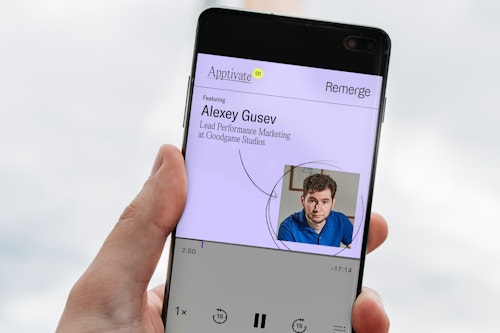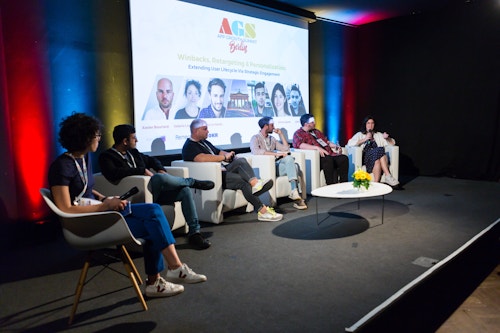How Will Gaming Apps Deal With SKAdNetwork 4.0?
August 15, 2022

The introduction of the SKAdNetwork in 2018, and the ATT rollout in 2020, means app marketers have had to change how they measure their app's performance. But now, with a new update on the horizon, how will things change?
We spoke with Alexey Gusev, Lead Performance Marketing at Goodgame Studios, as part of our Apptivate podcast, to understand how his team adapted its performance measurement strategies with the SKAdNetwork for every game, regardless of genre. We also talked about how SKAdNetwork 4.0 could change its mobile game strategies.
What is SKAdNetwork again?
The SKAdNetwork framework, also known as SKAN, is a user-privacy-preserving approach that provides validation of advertiser-driven app installations in combination with campaign and attribution measurement capabilities. The framework fully aligns with Apple's latest data safety and security regulations and is compatible with all iOS 14.5 devices or higher. The SkAdNetwork API forwards postbacks upon installs or reinstalls.
Back in 2018, advertisers were given IDFA access as a default. While there was an option to opt-out of ad tracking, most users didn't and so SkAdNetwork was not widely adopted within the mobile industry. But with the introduction of the ATT (App Tracking Transparency) framework in 2020, the game shifted. Advertisers could now only obtain IDFA data for users who had opted-in to ad tracking for their app. ID traffic has since dropped and more developers have started using SkAdNetwork, which has become an attractive solution as it allows for install attribution measurement without user consent.
Things are set to change again with the 4.0 rollout. The new update makes the API more usable, however, these updates won’t be live until Autumn 2022 (more on that later).
For now, let’s focus on how Goodgame Studios has adapted ad campaign measurement for SKAdNetwork and how they reacted to the ATT rollout back in 2020.
« When the ATT rolled out we decided to double-down on SKAN and tried to be ahead of the market »
Alexey Gusev, Lead Performance Marketing, Goodgame Studios
Goodgame Studios: Their reaction to SKAN and the ATT rollout
Goodgame Studios is a mobile game publisher and developer and part of The StillFront Group. Alexey works within the in-house marketing agency in a team of five, managing up to eight different gaming titles.
Goodgame’s portfolio is varied and includes casual/hyper-casual genres to hardcore titles — but their mobile marketing and measurement approaches are very different depending on the game genre.
As most app marketers would agree, launching a new game is always exciting, and analyzing those first KPIs is a huge milestone in any game launch — how successful is it looking? Are users loving playing it? When Goodgame Studios launched their game BitLife, for example, they already had the game setup in multiple languages, so they had a rough idea of KPI expectations, and it monetized quickly.
With changes to the IDFA and ATT rollout over the last year and a half, every one of their gaming apps had to reprogram itself to track and optimize campaigns in a world where IDs are less accessible — which can be challenging. The team had to learn about SkAdNetwork and how to leverage it across different titles.
“What we learned during this whole process is that every title, every game–not even every genre–every game needs to be approached very differently.” — Alexey Gusev
ATT has affected Goodgame Studios differently across different titles
Goodgame Studios found that iOS is most profitable for hardcore titles with a long monetization cycle. But finding a long-term solution was a steep learning curve for the team.
“When the ATT rolled out we decided to double-down on SKAN and tried to be ahead of the market and work with the solution we’d have to stick with in the future.” — Alexey Gusev
For every hardcore game, the team had to understand what conversion values they wanted to keep, which events they’d like to see, which revenue brackets they didn’t want to lose, the refresh interval they’d like to adopt, and much more.
After a lot of experimentation, the team found an optimal solution. They adopted a seven-day optimization and combined the timers to give a rough idea about retention values and paired that with monetisation.
“We essentially had something that pinged when the user was playing, or logged into the game every several hours, in order to prolong this 24-hour activity timer and then record as many purchases as possible.” — Alexey Gusev
This is a brand new world for technical developers and the Goodgame team experienced some communication obstacles — but overall, they were satisfied with the results.
There is no uniform way to measure with SKAdNetwork
It's important to approach every title and every game differently — they all require their own measurement strategy. App marketers require a deep understanding of what’s going with the events, how the user journey works, what revenue packages are most popular etc.
During episode 131, Alexey Gusev and Tommy Yannopoulos, Remrge’s Apptivate host, discussed that hyper casual games can be easier to manage than hardcore games. Hyper casual games have a more straightforward user flow, whereas, with hardcore titles, marketers must consider complex user patterns and behaviours.
“If it’s a hyper-casual genre, within 24 hours you have plenty of events. It gets a bit tricker when we’re stepping into the mid-core, hardcore genres where just the volume of the events is completely different and the user behavior patterns are way more complex in comparison to the rather straightforward casual user flow.” — Alexey Gusev
App marketers can’t access the granular information they need
Even with great infrastructure, there are fewer gaming insights when relying on the SkAdnetwork. App marketers cannot access granular information, so instead, the focus is on other things to compensate for it and to catch patterns. At Goodgame Studios, their number of dashboards has increased; this allows the team to observe market influence, organic lift, and uplift in general. If the user accepts the IDFA, everything needs to be married together.
Alexely noted that companies must ensure they’re acquiring users and retargeting old users.
What SKAdNetwork 4.0 means for the app measurement landscape
The biggest changes Alexey and his team have noticed with the upcoming SkAdNetwork 4.0 are the different timer windows. At the moment, there’s only one postback/conversion for each install, but with the new update, there will be three postbacks.
Each postback will be up for two, seven and 35 days, which means app marketers will now be able to understand user retention to some degree and track their activity level over a more extended period. So marketers will gain important insights into retention and long-term purchasing behavior.
User privacy is important to Apple, and rightly so. However, with the new updates the privacy threshold will no longer be black and white. Instead, it will be categorized as low, medium or high tier. If an app receives a relatively low install count, Apple cannot share as much data with the advertiser because they need to protect the user’s privacy. But the higher up the tiers it reaches, i.e. medium and high, the more data Apple can share with the advertiser, as the user becomes more anonymous.
Although the granularity of the data will not be as rich as the days prior to the ATT rollout, there will be more data in general for app marketers to sink their teeth into, compared to previous SKAdNetwork versions. This offers a lot of opportunities for technical integration — but the model itself has become more complicated for user position managers, which means they’ll need to rely on support from others to understand it properly.
Listen to the full podcast episode with Alexey Gusev.





